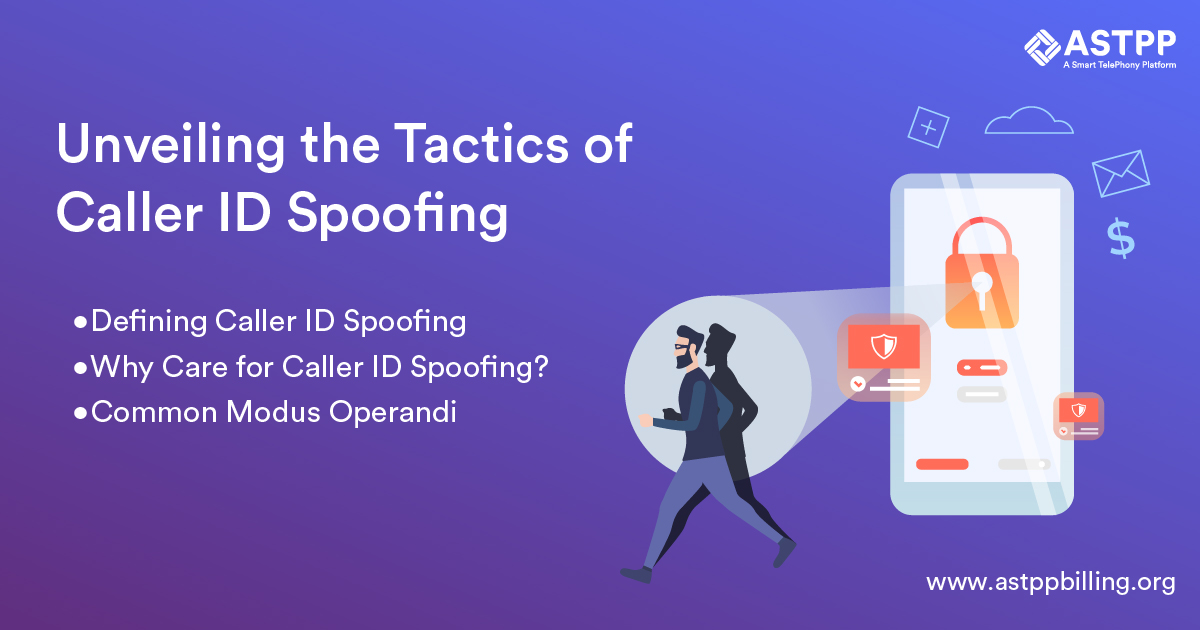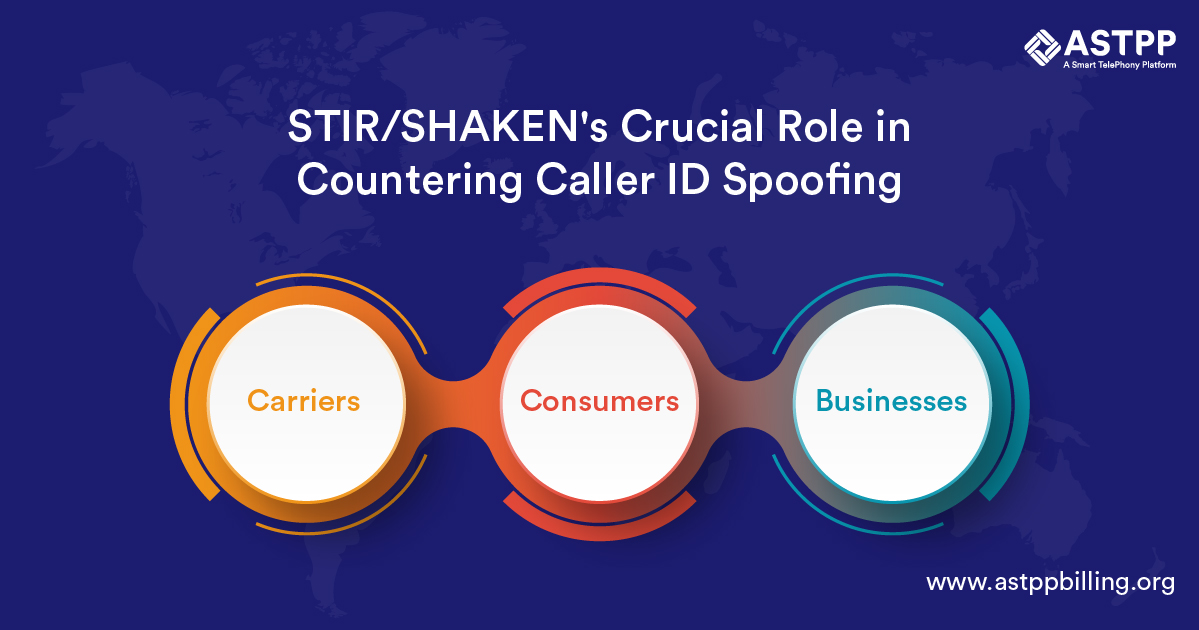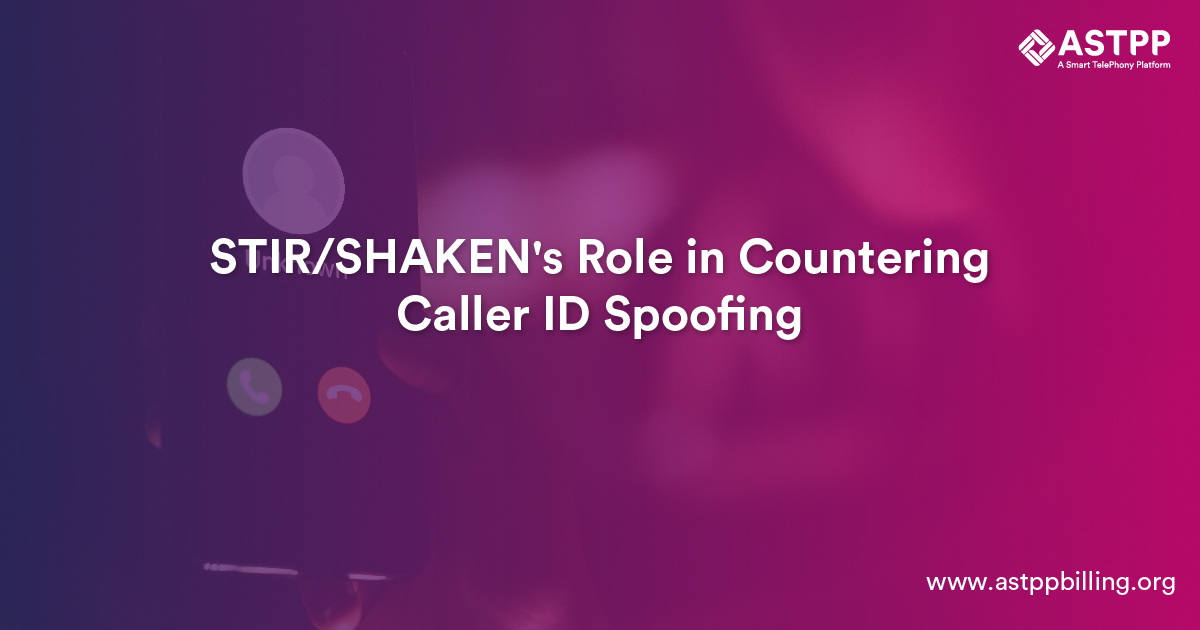VoIP frauds are pretty common in the SIP telephony industry. Obviously, even in traditional telecommunication, fraud calls are possible. However, in the realm of internet communication, fraudsters exploit vulnerabilities, engaging in Caller ID Spoofing, intercepting lines, and tricking people for malicious intent. In short, in the VoIP network, it is quite easy to get attacked and hampered. Therefore, there is a need to build protocols and solutions that can prevent these attacks. However, it is difficult to tame it completely. So, it is necessary to use tools that can alert customers about possible fraud attempts by a caller. The STIR/SHAKEN solution is one of the security tools that work in this direction.
Combat Caller ID Spoofing effectively with our cutting-edge STIR/SHAKEN Solution.
Combat Caller ID Spoofing effectively with our cutting-edge STIR/SHAKEN Solution.
STIR/SHAKEN has been in the industry for several years. However, it has become the talk of the town in 2021. The clear reason behind increased discussion about this fraud detection and prevention mechanism is that the FCC (Federal Communications Commission) has mandated this protocol. One of the major reasons behind the imposition of STIR/SHAKEN is due to increasing cases of caller ID spoofing. Let’s delve deeper into this subject matter to learn about this security mechanism.
1. Understanding VoIP Frauds
In simple words, VoIP fraud is an attack on a network or individual in which a fraudster intercepts to fulfill his or her malicious intent. Attackers carry out VoIP fraud either to make money or to harm providers or consumers. In any case, it is dangerous.
In other words, a fraudster attacks a VoIP device or line or in any other way to make money. However, either a provider or a customer must pay the price. This causes adverse effects on both customers and providers as they have to face financial loss. Moreover, there is a trauma and legal consequence to face. Therefore, it is necessary to tackle these situations in advance.
A majority of VoIP software provider companies and VoIP software development companies are aware of these scams and attacks. Therefore, they invest in inventing secure communication solutions. Moreover, they develop security tools and solutions to prevent fraud attacks. However, it is not possible to stop these attacks completely. Therefore, all VoIP service providers must focus on taking preventive steps to combat attacks.
There are different types of VoIP attacks. Some popular VoIP frauds are listed hereunder:
- DoS (Denial of Service) attack
- DDoS (Destructive Denial of Service) attack
- Toll fraud
- Caller ID spoofing (CLI spoofing)
- Robocalls
- False Answer Supervision (FAS)
- Call hijacking
- SIP registration attack
- IP PBX hacking
- WANGIRI
- Call reselling
- IRSF (International Revenue Sharing Fraud)
To learn more about major and trending fraud attacks in 2023, you must read our blog post, here. This blog post shares four major attacks that are taking the VoIP industry over the storm. Having information about major attacks can help you take preventive steps and keep your business and customers safe.
2. Understanding Caller ID Spoofing

Caller ID spoofing has become a major concern in the USA and across the world. Robocalls and caller ID spoofing are highly correlated. According to the statistics, in the first six months of 2023, people in America received a whopping 31 billion robocalls (Source). This number was 78 billion in 2022. Moreover, 40% to 60% of these calls were caller ID spoofing.
Defining Caller ID Spoofing
It is a type of scam call. The attacker falsifies the originating number. Moreover, the call receiver’s caller ID shows this falsified number. Moreover, the falsified number is more like someone the recipient would trust too easily like a neighbor, a friend, a family member, or even someone from the authority. Caller ID spoofing is the process of tempering caller ID.
Why Care for Caller ID Spoofing?
Back in the 90s when caller ID was invented, it was considered a boon for consumers. It lets people decide whether they are interested in attending the call or not. This introduced a vetted calling experience for consumers. The problem started when attackers found a way to hamper people through caller ID spoofing.
It is very easy to trick people by an imposter who pretends to be someone the call recipient already knows. For example, the caller ID of a family friend makes it easy to believe that the friend is in need and that someone from his or her family is calling to ask for temporary monetary help.
Attackers that attack with caller ID spoofing may have different intentions. They call just for fun or to waste someone’s time for sadistic pleasure. However, major cases are related to attempting financial fraud. Moreover, some attackers also intrigue people to share sensitive information. This information is used against them to harm them in the future. In short, the consequences of caller ID spoofing are vicious. Therefore, it is necessary to combat them.
Common Modus Operandi
In general, attackers run a campaign of robocalls. Attackers put the people who attend these calls into the favorite category to carry out attacks with caller ID spoofing. Therefore, attackers call them to meet their malicious intent with caller ID spoofing.
3. Understanding STIR/SHAKEN
As now you have a great understanding of caller ID spoofing, you must take the next step to learn about STIR/SHAKEN. The STIR/SHAKEN solution helps in effectively combating this nuisance of caller ID spoofing. It has proven its worth. As a result, the FCC has mandated the use of it for all telephony service providers, carriers, and operators that are directly or indirectly serving customers in the USA. In fact, STIR/SHAKEN has saved the VoIP telephony industry in the USA.
Read our interesting blog post covering how the STIR/SHAKEN framework has protected the US telephony business in detail.
Defining STIR and SHAKEN
Even if the STIR/SHAKEN name is used as a single word, they are two different phenomena. In combination, it is a security protocol or framework that effectively manages caller ID spoofing attacks and protects customers. It alters customers about possible fraud attempts and spoofed caller IDs. As a result, customers can take a more conscious call while asked for any type of favor or information.
To understand STIR and SHAKEN, let’s understand both of these terms in detail.
Understanding STIR
Secure Telephony Identity Revisited is full form or STIR. It is a security protocol that defines a secure way of attaching a digital signature with a call. Moreover, this signature will also have the right information about the calling party. This digital signature is also referred to as a digital certificate. This digital certificate is attached with a SIP header or message while transmitting packets to the receiver. The SIP header message often consists of details of the calling and called party and the attached digital signature verifies the identity of the calling party. This protocol was invented by (the IETF Internet Engineering Task Force).
Understanding SHAKEN
Secure Handling of Asserted Information Using ToKENs is a full form of SHAKEN. This is the framework that incorporates an effective way of attaching STIR protocol within a SIP call. In other words, it makes it possible to send a digital signature with the SIP call.
STIR/SHAKEN
These two protocols work together as an effective way to attach verification information of the caller and send it to the carrier. Moreover, it provides enough details to the carrier, so that he or she can verify the authenticity of the caller ID. As a result, carriers can detect whether a caller ID is genuine or not.
This is the most effective way of combating caller ID spoofing. That is why for many years FCC has been advocating STIR/SHAKEN for many years. Moreover, the FCC mandate is finally to ensure all providers use the STIR/SHAKEN framework to protect Americans from one of the very well known fraud attacks and that is caller ID spoofing.
4. Role of STIR/SHAKEN in Combating Caller ID Spoofing

You must have understood the STIR/SHAKEN protocol by now. Therefore, you must have already sensed how important its role is in the VoIP telephony network. Let’s discuss how effectively it manages caller ID spoofing attacks and benefits consumers, carriers, and businesses.
Carriers
The major advantage of the carrier of using the STIR/SHAKEN framework is protecting customers. Certainly, this may sound like a small benefit if you are not a carrier or service provider. However, it is a big thing because as a provider you are ensuring secure services to your clients. As a result, you can win more clients. Furthermore, you can retain them by saving them from robocalls and caller ID spoofing attacks. In addition to that, you can constantly gain positive brand image related benefits. For example, steady growth of revenue.
Consumers
The biggest advantage of STIR/SHAKEN is for consumers. They will enjoy a harmless calling experience. The role of the security tool discussed is to alert customers by showing the authenticity of the caller ID. Therefore, customers can avoid robocalls and spoofed calls. As a result, they can enjoy better and more secure telephony solutions.
Businesses
Several businesses were facing concerns due to the increased number of robocalls and spoofed calls. Even genuine businesses were questioned for their intent. As a result, these businesses used to face several negative impacts on their business. The invention of STIR/SHAKEN has made it easier for businesses to prove their identity over telephonic conversations. As a result, they can run their sales, marketing, and customer care campaigns more effectively.
5. Necessity of STIR/SHAKEN
This is an important question for many providers and customers. Certainly, it is necessary for customers because it gives them comfort and confidence in using VoIP calling services. Moreover, it also keeps them protected from fraudulent attacks.
Again, for providers, it is mandatory to use a STIR/SHAKEN certificate if they want to do business in the USA. Since July 2021, it has been compulsory for providers to use this security mechanism. However, in other countries, it is not mandatory to implement. However, it is still recommended to use this security mechanism to protect businesses and customers. Therefore, even if it is not mandated by the legislation, a provider or operator must implement STIR/SHAKEN.
6. Ways to Implement STIR/SHAKEN Certificate
STIR/SHAKEN implementation is somewhat like coding for software users. There are several ways to implement this certification depending on different criteria. For example, you can use your own expertise to implement this certificate if you have coding knowledge. Moreover, you can take the help of a company like a VoIP custom development company to implement the STIR/SHAKEN certificate.
There are also different technical details related to the STIR/SHAKEN certificate. For example, you have the option of implementing either an open source or an enterprise certificate. Moreover, you have the option of implementing full attestation, partial attestation, and gateway attestation. Depending on the attestation level, the security level is defined. Therefore, it is necessary to decide the right level of STIR/SHAKEN protocol to leverage the right advantages.
Concluding Note
In conclusion, in the VoIP telephony industry, security is a major concern for everyone. For example, operators, providers, customers, and even the government are concerned about fraud attempts. Caller ID spoofing is one of the major security concerns in the VoIP industry. Therefore, it is necessary to combat it effectively. STIR/SHAKEN protocol is the most effective solution to tackle fraudsters and attackers spoofing caller IDs to hamper consumers. We have covered how it helps carriers, businesses, and customers by handling spoofed calls more efficiently.
We have been one of the renowned VoIP software solution providers worldwide. Moreover, we are renowned for our security tools and solutions. We have shared a lot of resources to help people make their VoIP businesses and networks more secure and protected. We help with STIR/SHAKEN implementation, too. If you are interested in implementing a STIR/SHAKEN solution for your business, then we can help. Connect with us to learn more about our offerings.





